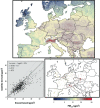Use of satellite observations for long-term exposure assessment of global concentrations of fine particulate matter
- PMID: 25343779
- PMCID: PMC4314252
- DOI: 10.1289/ehp.1408646
Use of satellite observations for long-term exposure assessment of global concentrations of fine particulate matter
Abstract
Background: More than a decade of satellite observations offers global information about the trend and magnitude of human exposure to fine particulate matter (PM2.5).
Objective: In this study, we developed improved global exposure estimates of ambient PM2.5 mass and trend using PM2.5 concentrations inferred from multiple satellite instruments.
Methods: We combined three satellite-derived PM2.5 sources to produce global PM2.5 estimates at about 10 km × 10 km from 1998 through 2012. For each source, we related total column retrievals of aerosol optical depth to near-ground PM2.5 using the GEOS-Chem chemical transport model to represent local aerosol optical properties and vertical profiles. We collected 210 global ground-based PM2.5 observations from the literature to evaluate our satellite-based estimates with values measured in areas other than North America and Europe.
Results: We estimated that global population-weighted ambient PM2.5 concentrations increased 0.55 μg/m3/year (95% CI: 0.43, 0.67) (2.1%/year; 95% CI: 1.6, 2.6) from 1998 through 2012. Increasing PM2.5 in some developing regions drove this global change, despite decreasing PM2.5 in some developed regions. The estimated proportion of the population of East Asia living above the World Health Organization (WHO) Interim Target-1 of 35 μg/m3 increased from 51% in 1998-2000 to 70% in 2010-2012. In contrast, the North American proportion above the WHO Air Quality Guideline of 10 μg/m3 fell from 62% in 1998-2000 to 19% in 2010-2012. We found significant agreement between satellite-derived estimates and ground-based measurements outside North America and Europe (r = 0.81; n = 210; slope = 0.68). The low bias in satellite-derived estimates suggests that true global concentrations could be even greater.
Conclusions: Satellite observations provide insight into global long-term changes in ambient PM2.5 concentrations. Satellite-derived estimates and ground-based PM2.5 observations from this study are available for public use.
Conflict of interest statement
The authors declare they have no actual or potential competing financial interests.
Figures






Comment in
-
The view from afar: satellite-derived estimates of global PM2.5.Environ Health Perspect. 2015 Feb;123(2):A43. doi: 10.1289/ehp.123-A43. Environ Health Perspect. 2015. PMID: 25643426 Free PMC article. No abstract available.
References
-
- Boys B, Martin RV, Van Donkelaar A, MacDonell R, Hsu NC, Cooper MJ, et al. Fifteen year global time series of satellite-derived fine particulate matter. Environ Sci Technol. 2014;48:11109–11118. - PubMed
-
- Brown KW, Bouhamra W, Lamoureux DP, Evans JS, Koutrakis P. Characterization of particulate matter for three sites in Kuwait. J Air Waste Manag Assoc. 2008;58:994–1003. - PubMed
-
- Chin M, Diehl T, Tan Q, Prospero JM, Kahn RA, Remer LA, et al. Multi-decadal aerosol variations from 1980 to 2009: a perspective from observations and a global model. Atmos Chem Phys. 2014;14:3657–3690.
Publication types
MeSH terms
Substances
LinkOut - more resources
Full Text Sources
Other Literature Sources

